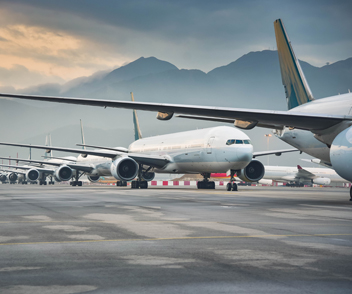The 1 minute dialogue
- In future, vertical take-off and landing “air taxis” will use electric or hybrid-electric propulsion to provide urban air mobility services to the public
- Before they’re a reality, challenges like infrastructure improvements, system safety, regulations/certification and insurance/risk management strategies will need to be formalized
- Existing regulations aren't conducive to the rapid development of unmanned passenger vehicles within the next five years
- Growth of this exposure poses new insurance risks like liability transfer and potentially large injury/damage claims, but generating sufficient data for actuarial analysis is key
Current state
Chinese manufacturer, Ehang, debuted the world’s first electric-powered unmanned passenger drone – the Ehang 184 – in 2016 in Las Vegas and around 1,000 test flights have since been flown. Simultaneously, to help boost infrastructure, Uber formed a ride-sharing and cargo delivery platform – Uber Elevate – to prepare for flight demonstrations in select US cities by 2020 with an eye to full operational capacity by 2023. It is seeking an "Uber International City" to similarly run test flights in either Japan, India, Australia, Brazil or France1 (the winner is announced later this year).
There are currently more than 130 companies producing and testing prototype eVTOLs, as tracked by the Vertical Flight Society (VFS) World eVTOL Aircraft Directory2. Such companies have attracted over $1bn in investment in a market valued between $500bn to $2trn – companies including some of the world’s largest aerospace manufacturers (Airbus, Bell, Boeing, Embraer), automotive companies (Audi, Honda, Rolls Royce, Toyota), and technology leaders/investors (Google, Intel, Uber). The potential is for over 100,000 commercial manned/unmanned electric aircraft to flood the UAM market once an integrated support system is in place3.
Yet, after applying operational constraints and barriers, only 0.5% (between $2.5bn and $10bn) of potential capital can be realized in the near term, according to the US National Aeronautical and Space Administration (NASA)4. Fully-operational eVTOL investment is a long-term play.
Before such technology is accepted, however, there are significant challenges, driven by four overarching areas: infrastructure; vehicle inventory; regulations; and safety.
Challenges
INFRASTRUCTURE
Perhaps the biggest challenge facing UAM integration is on-ground support infrastructure5. Airports aren’t the answer, due to safety concerns, so landing areas, charging stations and customer access points are required. German start-up, Volocopter6, envisions a network of rooftop “voloports” serving around 10,000 UAM passengers per day.
Airspace control is also important. An air traffic control (ATC) system monitoring air taxis and traditional traffic isn’t currently possible – safe integration of manned and unmanned traffic is best accomplished through autonomous Unmanned Traffic Management (UTM) systems.
“Beyond visual line of sight (BVLOS) operations will expand and enable flights only after autonomous UTM systems are available and fully functional,” says Tom Chamberlain, Underwriting Manager, Aerospace and General Aviation, AGCS. Further, once fully integrated, cybersecurity of the entire operation will become paramount.
“Redundant critical components, along with functioning sense-and-avoid technology and clear airborne priority rules, will also be required and will make eVTOLs more safe,” adds Thomas Kriesmann, Senior Underwriter, General Aviation, AGCS.
But, first, there have to be vehicles to meet the demand.
VEHICLE INVENTORY
Although many companies are investing in various concepts, and some already flight-testing, the lack of inventory is a major problem. “Before being functional, years of vehicle testing and development are needed. Operational services, at least in the US, are years away,” says James Van Meter, Regional Head of Aviation Programs & Product Development - North America, AGCS.
One bottleneck is battery capacity, as power loss is a safety issue. Charging requirements need to evolve from recharging after every flight to recharging after five or so flights for full operational functionality. Performance degradation occurs as batteries lose power during flight, whereas efficiency actually improves as fuel is burned and weight is decreased with conventional aircraft.
Thousands of eVTOLs will need to be ready once UAM services launch – estimated to reach 23,000 by 2035, in a $32 billion passenger market. Currently, no company makes more than 700 vehicles a year. Mass production will require considerable investment7.
REGULATIONS
Regulatory approvals and certification testing for eVTOLs will also need to be worked out, difficult in the US and, to a lesser degree, Europe. Conversely, Asia and Middle East markets are more ready to roll. Only Dubai and Singapore are developing air taxi systems to launch within the next few years, although unmanned cargo operations are in full test-mode in 64 municipal areas around the world8.
“Existing regulations aren’t conducive to the rapid development and implementation of unmanned passenger vehicles within the next five years or more,” says Ryan Wallace, Assistant Professor, Department of Aeronautical Science, College of Aviation, at Embry-Riddle Aeronautical University. The FAA is shy about integrating UAM technology into national airspace, a position likely to harden as more near-misses with small unmanned aircraft are reported at airports.
Less conservative, the European Aviation Safety Agency (EASA) issued a proposal of airworthiness standards in October 2018 to clear initial hurdles enabling the safe operation of piloted air taxi and eVTOL aircraft in Europe9 – unmanned regulations have not yet been codified.
As UAM technology contributes new propulsion systems and vehicles that haven’t been certified or addressed by regulations10, stringent testing requirements will necessarily follow.
SAFETY
The transition to unmanned passenger service will require substantial shift of public trust. A fatal accident in the early years of development would damage confidence, investment and enthusiasm for the technology. The key to this technology will be a demonstrably safe, well-tested and certified vehicle.
According to a YouGov survey, only a quarter of US adults have heard of unmanned passenger drones and 54% reported they wouldn’t feel safe in one. Only 5% felt safe enough to ride in one11.
“People already travel on unmanned vehicles in most airport terminal shuttles and commercial flights routinely operate on autopilot, without thinking of safety,” says Chamberlain. Autonomous vehicles are predicted to eventually be safer than traditional aircraft.
Without a pilot onboard, a new automated communication and guidance system will need to be developed, performing identical functions as a manned crew while rapidly responding to ATC instructions to avoid traffic, weather or similar hazards. Safety measures will have to be robust to attract riders – and investors.
In case of accidents, liability questions will shift from pilots to developers, manufacturers or operators. “Given today’s litigious conditions, I doubt most companies will roll-out a product without substantial validation testing,” says Wallace. This is where we enter the domain of insurance.
Insurance and air taxis
Like any new product, risk exposures will need to be assessed by insurers, but adequate historical data doesn’t yet exist. “From a risk standpoint, it will be important to generate sufficient data and make it available to all stakeholders,” says Kriesmann.
Once authorities have cleared the technology, the public may embrace it and insurers will step-up their commitment to offer solutions. Hull and physical damage coverages will be similar to aviation coverages that already exist, while liability scenarios will change.
“I think this process will dramatically deviate from the path smaller unmanned aircraft systems (UAS) insurance has taken,” says Wallace, “since the amount of damage or injury capable of being inflicted is relatively minimal. With a human passenger onboard, the potential liability escalates considerably.”
“Aviation insurance will continue evolving and the industry will develop insurance products to understand, mitigate and manage risk and create the safest possible environment for eVTOLs to thrive, once the market evolves,” says Van Meter.
Increasing airport drone intrusions
Severe disruptions occurred at Gatwick Airport, London’s second busiest airport, resulting in 1,000 flight cancellations or diversions and affecting 140,000 passengers, when recreational “drones” reportedly appeared over the airport for three days in December 2018. Similar drone incidents with airliners or near airports occurred in late 2018 and early 2019 in Tijuana, Mexico; Newark, New Jersey; and London's Heathrow Airport - to name but a few.
Flight intrusions are increasing as more drones and pilots enter the market, explains Chamberlain. The incidents at Gatwick were monitored closely by the aviation industry; coincidentally, beginning in 2019, UK drone owners will be required to register their vehicles over 250g– similar to what pilots in Australia and Germany have done for some time.
“We’re also asking the authorities to look at requiring drone pilots to be insured, as with automobile drivers. After all, the risks remain the same,” Chamberlain concludes.
Download the Global Risk Dialogue
1. Uber Elevate, Press Release, August 30, 2018
2. Vertical Flight Society, eVTOL Aircraft Map (companies and test flights), http://evtol.news/evtol-aircraft-map/
3. Vertical Flight Society (VFS), press release, November 2018
4. National Aeronautical and Space Administration (NASA), Executive briefing: UAM market study, October 5, 2018
5. Washington Post, This company says its air taxis could be flying people across major cities by the ‘mid-2020s’, January 10, 2019
6. The Verge, Volocopter envisions ‘air taxi’ stations that can handle 10,000 passengers a day, April 17, 2018
7. Porsche Consulting, The future of vertical mobility: Sizing the market for passenger, inspection and goods services until 2035, 2018
8. Unmanned Airspace, Urban air mobility takes off in 64 towns and cities worldwide, December 10, 2018
9. EASA, press release, October 15, 2018
10. Inside Unmanned Systems, Urban Air Mobility: Catching a very local flight, April 20, 2018
11. CNBC, Would you feel safe riding a passenger drone? According to research, most Americans wouldn’t, July 10, 2017
Allianz Group companies
AGCS offices
Newsletter
Keep up to date on all news and insights from AGCS















